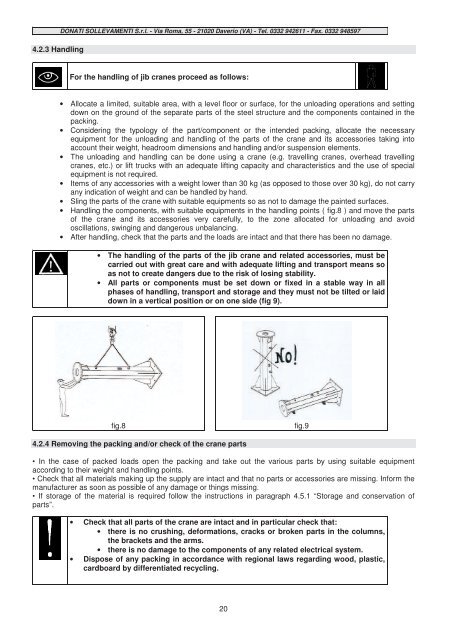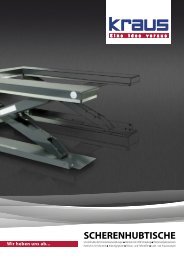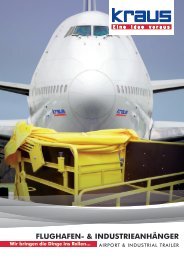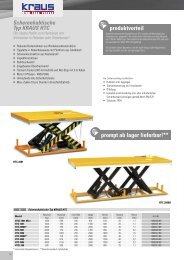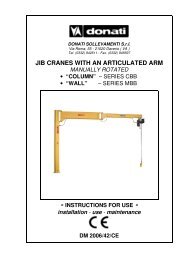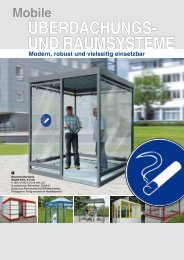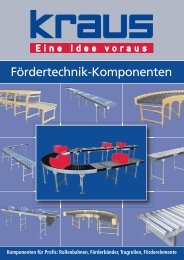COLUMN JIB CRANE - INSTRUCTIONS FOR USE -
COLUMN JIB CRANE - INSTRUCTIONS FOR USE -
COLUMN JIB CRANE - INSTRUCTIONS FOR USE -
You also want an ePaper? Increase the reach of your titles
YUMPU automatically turns print PDFs into web optimized ePapers that Google loves.
4.2.3 Handling<br />
DONATI SOLLEVAMENTI S.r.l. - Via Roma, 55 - 21020 Daverio (VA) - Tel. 0332 942611 - Fax. 0332 948597<br />
For the handling of jib cranes proceed as follows:<br />
• Allocate a limited, suitable area, with a level floor or surface, for the unloading operations and setting<br />
down on the ground of the separate parts of the steel structure and the components contained in the<br />
packing.<br />
• Considering the typology of the part/component or the intended packing, allocate the necessary<br />
equipment for the unloading and handling of the parts of the crane and its accessories taking into<br />
account their weight, headroom dimensions and handling and/or suspension elements.<br />
• The unloading and handling can be done using a crane (e.g. travelling cranes, overhead travelling<br />
cranes, etc.) or lift trucks with an adequate lifting capacity and characteristics and the use of special<br />
equipment is not required.<br />
• Items of any accessories with a weight lower than 30 kg (as opposed to those over 30 kg), do not carry<br />
any indication of weight and can be handled by hand.<br />
• Sling the parts of the crane with suitable equipments so as not to damage the painted surfaces.<br />
• Handling the components, with suitable equipments in the handling points ( fig.8 ) and move the parts<br />
of the crane and its accessories very carefully, to the zone allocated for unloading and avoid<br />
oscillations, swinging and dangerous unbalancing.<br />
• After handling, check that the parts and the loads are intact and that there has been no damage.<br />
• The handling of the parts of the jib crane and related accessories, must be<br />
carried out with great care and with adequate lifting and transport means so<br />
as not to create dangers due to the risk of losing stability.<br />
• All parts or components must be set down or fixed in a stable way in all<br />
phases of handling, transport and storage and they must not be tilted or laid<br />
down in a vertical position or on one side (fig 9).<br />
fig.8<br />
4.2.4 Removing the packing and/or check of the crane parts<br />
• In the case of packed loads open the packing and take out the various parts by using suitable equipment<br />
according to their weight and handling points.<br />
• Check that all materials making up the supply are intact and that no parts or accessories are missing. Inform the<br />
manufacturer as soon as possible of any damage or things missing.<br />
• If storage of the material is required follow the instructions in paragraph 4.5.1 “Storage and conservation of<br />
parts”.<br />
• Check that all parts of the crane are intact and in particular check that:<br />
• there is no crushing, deformations, cracks or broken parts in the columns,<br />
the brackets and the arms.<br />
• there is no damage to the components of any related electrical system.<br />
• Dispose of any packing in accordance with regional laws regarding wood, plastic,<br />
cardboard by differentiated recycling.<br />
20<br />
fig.9


